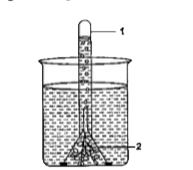Place a variegated garden croton in sunlight for a day. Test one of its leaves with iodine solution Explain what happens.
Step-by-Step Solution:
1. Understanding the Experiment: The experiment involves placing a variegated garden croton (a plant with both green and non-green parts) in sunlight for a day. The purpose is to observe the effects of photosynthesis on the leaves.
2. Photosynthesis and Chlorophyll: Photosynthesis is the process by which plants convert light energy into chemical energy, using chlorophyll (the green pigment in leaves). Chlorophyll is essential for this process as it captures sunlight.
3. Preparation for Testing: After keeping the plant in sunlight for a day, select a leaf from the variegated garden croton. This leaf will have both green (chlorophyll-containing) and non-green (lacking chlorophyll) areas.
4. Iodine Solution: Iodine solution is used to test for the presence of starch, which is a product of photosynthesis. When iodine comes into contact with starch, it changes color to blue-black.
5. Testing the Leaf: Place the selected leaf in iodine solution. Observe the color change in different parts of the leaf.
6. Observations:
- Green Part: The green areas of the leaf will turn blue-black, indicating the presence of starch. This shows that photosynthesis occurred in these areas due to the presence of chlorophyll.
- Non-Green Part: The non-green areas of the leaf will not change color and may remain brownish. This indicates that no starch is present, confirming that photosynthesis did not occur in these areas due to the absence of chlorophyll.
7. Conclusion: The experiment demonstrates that chlorophyll is necessary for photosynthesis. Only the green parts of the leaf, which contain chlorophyll, were able to produce starch when exposed to sunlight.
- Green Part: The green areas of the leaf will turn blue-black, indicating the presence of starch. This shows that photosynthesis occurred in these areas due to the presence of chlorophyll.
- Non-Green Part: The non-green areas of the leaf will not change color and may remain brownish. This indicates that no starch is present, confirming that photosynthesis did not occur in these areas due to the absence of chlorophyll.
Topper's Solved these Questions
- PHOTOSYNTHESIS AND RESPIRATION IN PLANTS BOOK - ICSECHAPTER - PHOTOSYNTHESIS AND RESPIRATION IN PLANTS EXERCISE - Exercises (Answer the following.)
3 Videos
- MODEL TEST PAPER IIBOOK - ICSECHAPTER - MODEL TEST PAPER IIEXERCISE - SECTION II
57 Videos
- PLANT LIFEBOOK - ICSECHAPTER - PLANT LIFEEXERCISE - EXERCISES (PICTURE STUDY)
10 Videos
Similar Questions
If the cell is placed in hypotonic solution, what will happen?
View SolutionA healthy Croton plant bearing variegated leaves was kept in a dark cupboard to destarch it after which it was placed in sunlight for a few hours. One of the leaves was then plucked and an outline of the leaf marking the green and the non-green regions was drawn. The leaf was then tested for starch. Using the above information, answer the following questions
State the aim of the above experiment.
View SolutionA healthy Croton plant bearing variegated leaves was kept in a dark cupboard to destarch it after which it was placed in sunlight for a few hours. One of the leaves was then plucked and an outline of the leaf marking the green and the non-green regions was drawn. The leaf was then tested for starch. Using the above information, answer the following questions
What change is seen in the leaf after the starch test
View SolutionA healthy Croton plant bearing variegated leaves was kept in a dark cupboard to destarch it after which it was placed in sunlight for a few hours. One of the leaves was then plucked and an outline of the leaf marking the green and the non-green regions was drawn. The leaf was then tested for starch. Using the above information, answer the following questions
Name the chemical used for testing the presence of starch.
View SolutionA healthy Croton plant bearing variegated leaves was kept in a dark cupboard to destarch it after which it was placed in sunlight for a few hours. One of the leaves was then plucked and an outline of the leaf marking the green and the non-green regions was drawn. The leaf was then tested for starch. Using the above information, answer the following questions
Why is the leaf boiled in water and alcohol before testing for the presence of starch?
View SolutionA healthy Croton plant bearing variegated leaves was kept in a dark cupboard to destarch it after which it was placed in sunlight for a few hours. One of the leaves was then plucked and an outline of the leaf marking the green and the non-green regions was drawn. The leaf was then tested for starch. Using the above information, answer the following questions
Give the chemical equation to represent the process of starch formation in plants.
View SolutionWhat happens to a plant cell when it is placed in a hypotonic solution ?
View SolutionOzone is a toxic gas and is a strong oxidising agent even then its present in the stratosphere is very important. Explain what would happen if ozone from this region is completely removed ?
View SolutionThe following diagram demonstrates a physiological process taking place in green plants. The whole set up was placed in bright sunlight for several hours. Study the diagram and answer the questions that follow:

What would happen to the rate of bubbling of the gan if a pinch of sodiam bicarbonate is added to the water in the beaker? Explain your answer
View SolutionExplain what will happen to a plant cell if it is kept in a solution having higher water potential
View Solution
